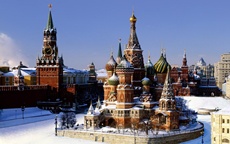Russia hikes key interest rate to 10.5% to fight inflation
12 Dec 2014
Bank of Russia, the country's central bank, has raised its key interest rate to 10.5 per cent from 9.5 per cent, just six weeks after increasing it from 8 per cent, as the bank is struggling to combat inflation caused by plunging oil prices and western sanctions imposed due to the country's involvement in Ukraine.
 The action follows a gloomy outlook for the Russian economy in 2015 presented by the World Bank earlier this week. The global lender predicted the world's eighth-largest economy would shrink by 0.7 per cent next year, the country's first recession since 2009 global economic downturn.
The action follows a gloomy outlook for the Russian economy in 2015 presented by the World Bank earlier this week. The global lender predicted the world's eighth-largest economy would shrink by 0.7 per cent next year, the country's first recession since 2009 global economic downturn.
The World Bank's estimate is based on a baseline scenario with an average crude oil price of $78 a barrel in 2015. If the situation worsens to $70 per barrel of crude, the economic contraction would be around 1.5 per cent, the World Bank said.
However, it expects oil price will to improve to $80 a barrel and Russia's GDP will grow at 0.3 per cent in 2016.
"Investment is projected to contract for a third year in a row in 2015, because of continued uncertainty, restricted access to international financial markets by Russian companies and banks, and lower consumer demand," World Bank economist Birgit Hansl said.
Rising inflation could pose a greater challenge to president Vladimir Putin. November inflation was high at 9.1 per cent due to weakening of the rouble, and the central bank predicts it to be around 10 per cent by the end of the year.
Prices of crude oil, Russia's main revenue earner, have hit fresh five-year lows and Brent was traded at $64.44 a barrel, around 44 per cent lower compared to its June high.
According to US Energy Information Administration's (EIA's) latest forecast, Brent crude prices will average $68 a barrel in 2015, which will be up to $5 a barrel below the current year's annual average.
The Russian currency is continuing its downward slide, despite the central bank's interventions. Last week, the bank pumped in $4.5 billion to prop up the currency. It has spent over $70 billion since January.
Despite the central bank action, the rouble fell to an all-time low of 55 to a dollar yesterday, and edging towards the 70 mark in relation to the euro. The rouble has lost about 42 per cent of its value since the beginning of the year.
According to the central bank chief Elvira Nabiullina, at current oil prices, the rouble is undervalued by 10-20 per cent. She further stated that the bank is determined to stabilise the currency despite the oil price slump.
''In case of further aggravation of inflation risks, the Bank of Russia will continue to raise the key rate,'' Nabiullina said.
This is the fifth time this year that the central bank has raised its key interest rate.
The bank forecasts 2015 inflation at 8 per cent and targets to bring it down to 4 per cent in 2017.
According to Nabiullina, the average oil price will be in the range of $80 a barrel in the next three years.
Bank of Russia also expects a weak GDP growth during 2015-2016 due to weakening of consumer demand. The central bank expects a near zero GDP growth in 2015-2016, which will pick up to 1-1.2 per cent in 2017.
In case of a crisis scenario of $60 a barrel of crude, the bank could use up to $85 billion to support the ruble, Nabiullina said. Russia's foreign currency reserves stand at around $416 billion.
Meanwhile, Russia signed a series of agreements yesterday with India covering several areas including defence, nuclear, energy, resources, technology, finance and other sectors. (See: India, Russia sign 16 agreements).